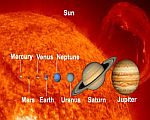- Home
- Subatomic Particles
- Undiscovered Particles
Undiscovered Particles - some weird theories
Undiscovered particles, for physicists, fall into two different categories: those that probably exist, they just haven't been found yet and those that only might exist, but it would be good if they did.
We'll be taking a look at them on this page.
The Graviton
Now that the Higgs boson appears to have been discovered, the next undiscovered particle yet to be found (or proved) is the boson that mediates the gravitational force - the graviton. This is currently one of the holy grails of physics. Its possible existence is very controversial, though, and this is why.
The unfortunate fact is, the prevailing theory of gravitation, that of Albert Einstein, states that gravity is the result of a curvature in space-time, which expressly negates the need for, or existence of, the graviton.
But, considering that the other three fundamental forces of the Universe are all mediated by force-carrying particles called bosons, it is not unreasonable to suppose that a similar mechanism exists for gravity, with a mediating boson, too. That's the assertion in the science known as quantum mechanics and it is thus in direct contradiction of Einstein's theory.
Just to remind you, Einstein's theory of gravity works perfectly well for massive objects, such as planets and their moons, but falls down within the quantum domain of the very tiny, where a theory of quantum gravity is required (which would involve the graviton).
Trouble is, at the centre of a black hole, which is very massive and very tiny at the same time, both theories would have to co-exist and therein lies the problem.
It has been suggested that, just as light behaves both like a wave and a particle, the same may apply to gravitation. That would be one way to resolve the issue.
To produce the effects of gravity, the graviton is thought to have a spin of 2 and, because it seems to have infinite range, to be massless.
Supersymmetry
I'd advise you to click through that link on "spin" in the above section before tackling this bit. Done that? Right...
In the second half of the 20th century, scientists came up with a theory to link fermions (quarks and leptons) with bosons - two very different types of particle. They suggested that every known elementary particle had a partner with a spin value one half unit less. Altering spin in this way would make a fermion's partner a boson and a boson's partner a fermion, thus linking them.
This concept was known as "supersymmetry" and they further suggested that all other quantum attributes of these particles would be the same as their partners.
However, some years later, the "Minimal Supersymmetric Standard Model" was proposed, which brought in the innovation that the partner particles had different mass than their original - possibly as much as one thousand times more. This explains why none have been discovered yet, as the energies required to create them has, so far, been too great for any particle accelerators on Earth. Until the Large Hadron Collider, of course, which currently is spending a lot of time looking for them.
Anyway, ready for a laugh? Here's what these undiscovered particles have been called...
Sparticles
Yes, that's the collective name for them. If we consider the individual names, however, it gets even worse.
In the case of fermions, their hypothetical partners are named simply by adding an "s" to the beginning of the name. This produces names ranging from the amusing to the downright silly.
So, first, we have the "squarks". Sticking to the added "s" rule rigidly, we end up with ridiculous names such as scharm squark and sbottom squark.
The other type of fermion, the lepton, has partners that are sleptons. In similar unfortunate fashion, the "s" rule results in selectron sneutrinos, smuons and staus. Can it get any worse?
Well, things are treated a bit more sensibly for bosons. Here, the -on at the end of each name is changed to -ino. Thus the undiscovered particles that partner bosons are bosinos. We then have the photino, the gluino and, in the case of the W and Z bosons, the excellently named wino and zino. The Higgs boson partner will be the higgsino.
The Undiscovered Particle of Dark Matter
Let's face it, dark matter, which pervades the whole Universe, in far greater amounts than ordinary, visible matter, must consist of some sort of particle. This, naturally, would be an undiscovered particle of major importance, so scientists are theorising as to what it might be.
One of the current best candidates for dark matter particles has another good name:
WIMP
This stands for "weakly interactive massive particle". The name is pretty much self-explanatory for its properties. It only reacts with the weak force and gravitation, while being unaffected by the strong and electromagnetic forces.
This results in its being extremely difficult to detect, as it doesn't react with light, meaning we can't see it. The fact that it's extremely massive also means that it's very difficult to create in particle accelerators.
The Neutralino
This is a type of "sparticle" not mentioned in the section above. It is created by combining the wino, zino, photino and a neutral version of the Higgs boson.
It has properties pretty much like the WIMP. A type of this particle, known as the "lightest neutralino", is one of the best candidates for the undiscovered particle of dark matter.
The Axino
This is the sparticle partner of another theorised particle, the axion. The existence of the axion was proposed in 1977 to explain something known as the "strong CP problem". Before you start to panic here's what that means:
It refers to something called "CP symmetry", which simply implies that physical laws should remain the same even if a particle is switched to its antiparticle (the C symmetry) or left and right were changed round (P symmetry).
This was found to work quite well for all particles - except for one known as the kaon (more correctly the K-boson). It was found that, during its weak force decay, the CP symmetry was broken. If that wasn't bad enough, it was only violated in the weak force, but apparently not in the strong force. Mathematical logic demanded if it happened in one, it should happen in the other.
The solution was the invention of the axion and it was suggested that there was a strong force violation, but the axion acted on it in some way, reducing it to such an extent that it was undetectable.
As regards the possibility of the axion being the dark matter particle, it had to be discarded, as its mass was far too small. Therefore, its sparticle partner, the axino, having far greater mass, was substituted.
The Sterile Neutrino
If you've read this site's page on leptons, you'll have seen that there are three known generations of them, the electron and electron neutrino, the muon and the muon neutrino and the tau and the tau neutrino.
Some scientists have proposed a possible fourth generation neutrino, nicknamed "sterile".
This name comes from the fact that they're theorised to only interact with gravity and no other fundamental force. This attribute makes them candidates for the dark matter particles.
The Chameleon Particle
This is a weird possibly undiscovered particle that has a unique property. Its mass alters according to where it is. It was postulated in 2003 to explain the rapid expansion of the Universe.
In the depths of space, it would have a small mass, whereas, if it approached a planet, such as Earth, it would acquire much more mass. This results in Earth-bound experimentation to find it being extremely difficult.
The chameleon has been thought of as not only a candidate for dark matter, but possibly dark energy, too.









Facebook Comments
Have your say about what you just read! Leave me a comment in the box below.